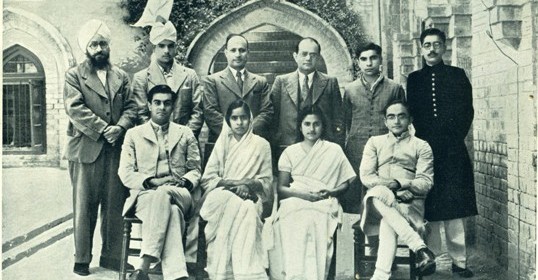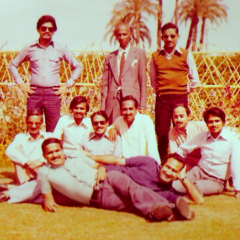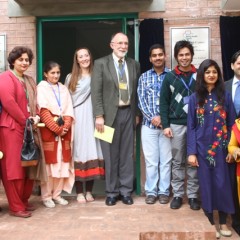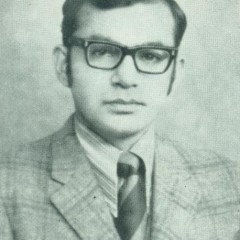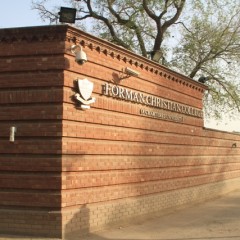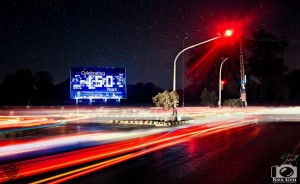27 Years at FCC
by Aroon Datta Our family moved to Forman Christian College campus when I was five and I left when I was 32 years old. In 1953, my father, T S Datta, joined the faculty as a professor of English. It seemed like we had moved into a beautiful state park or, better still, a beautiful, extremely well-kept garden. The meticulous lawns, the trimmed and manicured hedges, and the sports grounds were all extremely well-maintained, and as green as they are to this day. Everyday, for ten years, I rode the FCC bus to Cathedral School — that bus with its distinctive blue color and its unmistakable smell of leather seats. Our gang generally occupied the rear of the bus, by design, of course. This habit of mine persisted in college, university, faculty meetings later on, and all during my professional life. In 1964, I joined Forman as a student of the sciences and proudly wore the blue college blazer and the badge (emblem) that read “By love serve one another”. The four years that followed were some of the best years of my educational career. I had the most fantastic teachers who inculcated into the minds of their students a love for the sciences and languages. I fell in love with chemistry from the very beginning and graduated from college in 1968 with a major in chemistry. It was a very proud moment for me, and also for my parents, when I was asked to join the chemistry faculty in 1970 after I received my MSc degree from the University of the Punjab. Actually, it was an unbelievable offer, one that I could not refuse, because up to that point I had only dreamed of teaching some day. After coming on board, I realized that all of a sudden my former teachers had now become my colleagues and I could “hang” out with them in the cafeteria at Lucas Centre!!! For years after that, I would get up from my chair every time one of my professors entered a room. And, by the way, it’s a pretty cool thing when your own father becomes your colleague. Rest assured, that needed some major adjustments in my everyday behavior as a young lecturer. I proudly served Forman Christian College from 1970-80 and then decided to move to the United States with my family. In search of more “enriched” bread and butter I made some career changes and chose to go into neuroscience research eventually–a bit different from organic chemistry at the end of the day. I may add here that due to my passion for chemistry, I have maintained my adjunct...
A Dream Come True
by Humza Bin Masood I would love to share my story as one of my dreams has come true. I got admission in BS (Hons) in 2011. I joined RCYG in my Freshmen year as a Coordinating Officer. In that year the Red Crescent Youth Group (RCYG) offered a 15-day Medical First Responder Course in collaboration with Rescue 1122. After that training, I came to know that when my brother died he needed CPR [cardio-pulmonary resuscitation] but at that time no one one knew it. By the time he reached hospital it was too late. It was a challenge for me and it was the dream of the founder [M Shafiq] of the Emergency Services that there should be 24/7 Emergency Services and a place where such service could be provided. Today, when Mercy Health Center was inaugurated, I was glad that I kept the promise I made to myself and the Founder of Emergency Services. The challenge which I accepted when I came to know that my brother required CPR at his last moments had been completed. At first people laughed at me asking how it could be possible that FCC would take such an initiative as it an institute whose priority is education, not health. Today I can say that it is possible and hard work is the key to...
Winner of February 150 Quiz: Irsa Mazhar
Congratulations to Ms Irsa Mazhar (roll number 13-29014) for scoring the highest number of points in the February 150 Quiz. Ms Irsa Mazhar got all the answers right. Her score was followed closely by those of Sunita Salamat and Fatima Khan. Please contact the Communications Office, N Block, Room 222, to claim your...
February 150 Quiz Answers
This is the third in our series of quizzes to celebrate FCC’s 150th anniversary. This quiz looks at some of the flora and fauna at FCC. Here are the correct answers for the February 150 Quiz: 1. Azadirachta indica is the botanical name for which species of tree growing in FCC? Answer: Neem 2. The Natural History Museum at FCC contains a specimen of a tuatara (Sphenodon punctatum), a reptile sometimes called the three-eyed lizard. Now an endangered species, approximately how long ago did it evolve? Answer: 200 million years 3. The elephant whose skeleton is now in the Natural History Museum was named Benazir for its remarkable qualities. The dead animal was bought in 1958 and buried in the Botanic Gardens before being exhumed and reassembled. How long was it buried? Answer: 1 year 4. The FCC elephant is of the subspecies Elephas maximus indicus. How many pairs of ribs does it have (or should it have, given that one of its floating ribs is missing? Answer(s): 18 pairs if based on Benazir; 19 pairs if based on the subspecies. Both answers are considered correct. 5.The jaman tree is widely grown on the FCC campus. The fruit, seed and leaves of this tree are used to treat a number of diseases in traditional medicine. Which disease is it NOT used to treat? Answer: Leprosy 6. Topiary is the practice of clipping the foliage of trees or shrubs to create a clearly defined shape. From which shrub on the entrance road from Zahoor Elahi Gate is the topiary with the letters F, C and C created? Answer: Orange jessamin (Murrayan exotica) 7. The banyan tree in D Ground is one of the largest and oldest trees on campus. Where does the root (no pun intended) of the word “banyan” come from? Answer: Banya, or merchant, who sat under these trees 8. The long-tailed shrike (one of the many birds sighted at FCC) is known for its hunting instincts and for impaling its prey on thorns. For this reason it is also called by which other name? Answer: Butcher bird 9. The Botanic Gardens is just one of the facilities available to FCC students for hands-on learning. Which of the following are ALL included in the area. Answer: Palm, fern, waterlilly 10. Scientists in FCC’s Department of Biological Sciences have developed a transgenic cereal with increased iron and zinc bioavailability. Which cereal is it? Answer:...
My First Day of Teaching
By Dr Rehan Siddiqui I came here in 1962, and at that time I was just 22 years old and much thinner than I am today, I weighed just 110 pounds. I was interviewed by Professor E J Sinclair who was the principal, and a very well known teacher and administrator. He asked me, “Rehan, will you be able to control the class? You know, you’re so thin.” I replied, “Yes sir, I can do it.” The day before my first class, I went to see the lecture room and it had these blackboards where you wrote on the lower part and then pushed it up. I tried to push it upward and I couldn’t, so I knew this was something that would be a problem. I remember I was up the whole night preparing. I was going to give my first lecture, and there were about 60 strong students, including some East African students, very smart, who were at FC at the time. When I started teaching, I filled the lower part, and then I started erasing it. Somebody at the back said, “Sir, you can pull it up.” I knew that I could not, so I said, “Wait a minute, you can copy whatever you want to, and then later on I will start writing the next part.” Professor Zia-ul-Islam, who is now Head of the Biology Department in the Intermediate side, was in my first class. Anyway, it was a good experience, and I enjoyed teaching from 1962 to 1966. This was the first period of my life at FC...
Behind the Brick Wall
by Rabia Anjum Many stories shared on this space are about students with ambitious dreams surrounding FCC, or with parents passionate about the heritage of the institute—but for me, FCC did not exist until a few months before my admission. Having lived in Lahore all my life, this may seem odd at first, but FCC was just a hazy illusio. Better known to me as FC College, the mention brought to my mind two main things: “boys” and “matriculation”. Being a product of O/A Levels through and through, I barely thought about it and tried to follow in the footsteps of my peers: I applied to a few foreign universities, and then to LUMS. I didn’t get far enough in the former as my parents disallowed me from pursuing an education abroad, and for the latter, my financial aid application didn’t go through. A month before my final A Level exams, I was devastated—where was I going to go? I didn’t want to be a doctor, let alone an engineer—I really just wanted to study Biology! To be honest, I had my heart set on LUMS—the buildings, the people, every corner seemed so familiar in just a few visits. I was a cell without DNA. So my mother and I were juggling various options in Lahore. She insisted on KC, while I pushed for PU … it was a bloodbath as neither of us was convinced. I had been to both institutes and I didn’t get the feeling I did in LUMS. Call me superstitious, but for me an institute was a whole package—and it all started with the ambiance. And then, one day we were passing by the all too familiar Zahoor Elahi Road, when my mother asks: “How about FC?” “What about FC?” “I hear they’ve been denationalized … and they have made great strides in the past few years. Even in Sciences.” “Okay. Isn’t it for boys?” “Why don’t we find out?” So that’s when she took a turn and for the first time in my nineteen years of life, I saw the institute in its entirety—not just a brick wall I passed by every other day, but a community, a purpose in itself. I didn’t take long to make my decision. As soon as I went past security and on my way towards N-Block, I knew it: this was it. My future institution. This place was my DNA! Three years into my Bachelors, it seems funny I thought the two places were the same. They are so very different, and I’m glad they are. Here at FC, I have the opportunity to toy with the...


